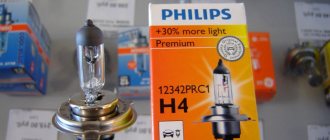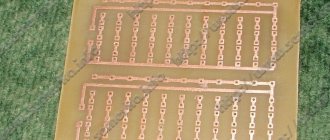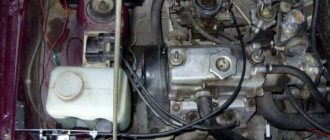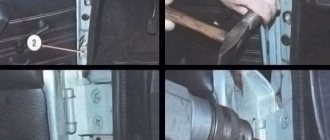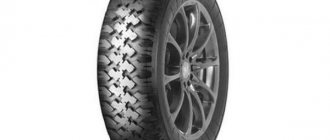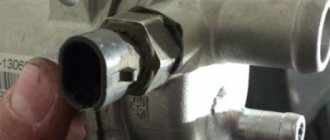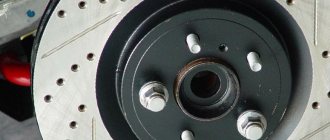Types of lamps
Halogen is the cheapest technology, but trusted automotive lamp manufacturers make them very efficient.
An old solution that is still the most popular, but loses a lot in terms of efficiency. I think that the H4 and H7 are very familiar to most car enthusiasts, not only in terms of their prevalence, but, above all, in the frequency of application of this or that solution. Access to these types of lamps is almost unlimited - you can find them not only at roadside gas stations, in regular supermarkets, but also (which is the fastest way) in online stores.
Xenon - this type of lamp provides the best lighting parameters for the road.
The xenon lamp is becoming more common and is used on a fairly wide scale - it differs in design and operating principle from a standard, say, H7, but this does not mean that it is inferior. In contrast, a xenon lamp, which operates on a gas called xenon, produces light with a much higher white intensity, so the area illuminated in front of the car is more visible and the range of the projected light is definitely better.
The cost of one original set (we are not talking about the so-called bi-xenons, where both low and high beams are implemented through xenon lamps) for a specific car model is usually several thousand rubles.
Expensive LEDs shine beautifully, “budget” ones work worse than xenon lamps and even incandescent lamps.
Contrary to what some people think, they are not eternal at all. Over time, LEDs lose their efficiency and produce less and less light. However, they are included in almost all car lamp ratings. In modern cars, LEDs are increasingly replacing classic light bulbs. They not only provide greater safety, but also a variety of design options and high energy saving potential.
Svetofar › Blog › About lenses in headlights and xenon (myths and more) ...
Initially, there was a lot that was unclear to me about this issue, but slowly, through my own efforts and experiments, I began to understand...
So, for reference in your own words: a lens (mono) a lens that performs the function of only low or high beam
Bi-lens, a lens that performs the function of both low and high beam,
Adaptive lens - turns after the steering wheel...
So myths and reality;
Differences between standard xenon and halogen lenses...
for the most part, the differences are only in the base of the lamps used and the shape of the curtain that forms the border of light,
And then we can talk a lot about the miracle engineers who specially calculated the shape of the reflector for the xenon lens and for the halogen lens separately... yes, visually the lens reflectors on the same car model (xenon and halogen) are different, but often this has practically no effect on the quality of light ( when installing a xenon lamp in a halogen lens) And the most interesting thing is that some halogen lenses (with xenon) shine better than xenon lenses from famous manufacturers such as Hella... and the point seems to be that halogen lenses collect light directing it to the road in front of the car, while xenon lenses have a wider angle of light propagation, spreading it along the roadsides (to the sides), although this has its advantage when driving along serpentine roads at night...
When installing xenon in lensed halogen headlights, first of all you should pay attention to the quality of xenon lamps; inexpensive Chinese lamps can be very crooked, with axial deviations of up to 2-3mm, respectively, or deviations in length from the installation plane to the light-emitting element by 0.5-1.5mm , accordingly, the element emitting light goes out of focus, and the lens does not work 100%. which affects the quality of light... But I didn’t notice any difference (relative to light) in the use of different ignition units. although I’ll make an amendment - cheap Chinese units can under-ignite the lamp and cause the lamps to flicker... Apart from the fact that there are 55W ignition units - xenon with which it shines brighter. For comparison, a regular halogen lamp emits light of 1500-2000lm. Xenon 35W gives light with a brightness of 3000-3200 lm. Xenon 55W - produces light with a brightness of 4000-4500 lm I have not seen standard 55W xenon...
More about standard xenon lamps;
D1S, D2S, D3S D4S - for lensed optics
D1R, D2R, D3R, D4R - designed for reflector type headlights (xenon headlights without lenses). These lamps have a pattern (curtain) made of heat-resistant paint, in the photo on the left is an R lamp, on the right is an S lamp
and the most interesting thing is that it doesn’t matter which of the 8 types of lamps is installed in a xenon lens, the light picture is the same, for all these lamps the distance from the plane to the middle of the light emitter is 27.1 mm, the only difference is the slots on the lamp base, which you can easily make yourself with using a needle file,
BUT ! there are nuances - these are standard ignition units; only lamps specified by the manufacturer are suitable for them, only the indices R or S do not matter, that is, for example, only D2S and D2R can be installed in the lens of the standard ignition unit, if you install a D2S lamp instead of D4S in the lens to the standard ignition unit then it won’t work, but you can hang D2S, D2R, D4S and D4R on the Chinese ignition unit... but the lamps may not ignite. Therefore, it is still worth using your own blocks for D4 lamps
in the photo in order D2R, D2S, D1S
Next is a small study to confirm the above; So we have a xenon mono lens from the 8th Honda Accord
and 3 lamps D2S (Philips) D2R (Osram) D2S China (No-name)
D2S (Philips) - recommended lamp (standard)
D2R (Osram) - lamp for reflector headlights (the light has remained virtually unchanged)
D2S China (No-name) differences are visible due to the light emitter being offset from the axis
but this is not a reason not to take lamps marked D (Chinese-Korean production), this is a reason not to take lamps from the cheapest segment, and when purchasing, inspect the lamps for curvature, appearance, presence of markings, absence of unprocessed plastic, presence of an iron holder between the plastic part and a glass flask...
The manufacturer recommends changing xenon lamps every 2 years; over time, the lamps change their color temperature and lose brightness, and buying lamps costs 2-3 thousand per piece. expensive for many, and half of those lamps that are sold under the guise of the original are just good Chinese fakes...
It will be useful: Replacing spark plugs Renault Logan 1.6 16
When buying an original lamp, advice: take a known original lamp (take it out of the headlight) and go to the store with it and visually look at the quality of yours and the one that is offered to you as the original, they should be as similar as possible, just the numbers of the part number and the color of the ceramic insulator the side of the bulb may differ, the quality of the inscriptions on the lamps must be the same...
The difference between new and old xenon lamps...
Often, customers with standard xenon headlights use this light for 5-6 years from the purchase of a new car, without changing xenon lamps, and if the lamps are of good quality, they still work, although at half their brightness... and when buying a used car, not many do they replace the lamps with new ones, although in some cases, where access to the lamps is not complicated by the design features of the car, you can take out the lamp and see the condition of its bulb... in the photo there is a new standard lamp
its core is almost transparent, and a small amount of yellow-brown salts is visible
In the next photo, the lamp has already worked well, the core is not transparent, it has become cloudy and has a dark gray color - such a lamp requires replacement, although the light is weak.
and in the third photo the lamp core darkened, and in addition, it boiled - the glass inside the core boiled from overheating - This often happens with D4 lamps, lamps in this condition do not shine well, they also need to be replaced
Well, another reason for a dying xenon lamp is a change in color... if the lamp begins to shine with lilac or pink light, it will soon fail. Let me remind you that the manufacturers of original xenon lamps recommend changing them every two years - with average mileage -. and I would recommend changing lamps from Chinese manufacturers once every year and a half...
What lamps should I buy?
H4 halogen bulbs are usually installed on small cars or older models, also because they are cheaper. H7 is used in more expensive cars, but their headlights must have two reflectors because, unlike H-Sevens H4, they only have one filament. H7 is smaller than the classic H4, so they work like a small radiator - 92% of the electricity is converted into heat.
The tungsten wire inside them can heat up to 3000 ° C. However, the quality of the bulb-reflector set determines the characteristics of the reflector. A review of car lamps showed that the large round headlight of the small VW Upa with an H4 bulb (manufactured by Hella) produces a much brighter light (as shown by measurements and subjective experience) than the smaller Ford Focus headlight with an H7 bulb. In the latter case, styling was probably most important, not lighting efficiency. Unfortunately, this is not an isolated case, as evidenced by testing of many headlights with small reflectors.
Rating of lamps with H1 base
This type of lamp is used as high and low beam in cars, vans and trucks. These days, they are one of the most commonly used types of car bulbs.
Inside the incandescent lamp there is one high efficiency filament with an H1 mount. These lamps offer a luminous flux of 1500/3200 lm. The height of the luminous flux depends on whether it is a traditional halogen lamp or a xenon HID lamp, which contains two gases - xenon and krypton. The service life of this type of lighting is at a very high level, because the vast majority of models available in stores shine from 400 to even 600 hours.
OSRAM COOL BLUE INTENSE H1
The quality and parameters of OSRAM Cool Blue Intense exactly meet the requirements set by car manufacturers upon first assembly. In this way, they provide lighting that makes the most of the headlights and thus influences driving safety.
Products from automotive lamp manufacturers OSRAM are used for the first assembly in every second new car. Car manufacturers don't compromise. Light source suppliers must meet the highest requirements.
GE TUNGSRAM Megalight Ultra
The high efficiency of the lamps provides better road illumination, an expanded driver's field of vision and improved night driving conditions. The TUNGSRAM Megalight Ultra+ series has been approved for use on public roads. The silver coating applied to the lamp ensures no glare.
TUNGSRAM is a guarantee of the highest quality products while maintaining an attractive price. TUNGSRAM Megalight Ultra + 130% lamps are placed in the same category as Osram Night Breaker Laser or Philips X-tremeVision.
Nissan Almera >› Logbook › Lensed halogen in the low beam + bulbs in the fog lights
As many have already guessed from the last entry, I was smart enough to stuff halogen lamps into Chinese xenon lenses, instead of, in fact, the xenon that was already there. It will be about how I came to this life, what motivated me to do this, and what came of it.
It’s not news that the Gays have long since reached out to the lensed illegal xenon drivers - in some regions it’s easier, in others it’s stricter, but in general the situation in the country is sad - drivers are being put under pressure, but are not offered an alternative. Or rather, there is an alternative - to formalize everything, but for this you need to go through the seven circles of hell and make money in each of the circles. This is in Moscow. In the provinces everything is even worse, because... there is physically nowhere to go. There are offices on the Internet that promise mountains of gold to process documents from US remotely, but there is no trust in them.
Yes, everything is done well for me - there is a washer, auto-corrector is now optional, the STG is licked to a shine, the stickers on the headlights are “ala original”. And I’ve never even been stopped for xenon, only once was a traffic cop stopped me because... one headlight went out - I saw the lenses, said something like “I thought they were like that...” and let me go. I’m sure that many people were not slowed down here either - a lot depends on the region and the mileage across the country. Nevertheless, the traffic police checkpoint near the city began to slow down the lens workers - this is how they came across a couple of people whom they knew personally. Both got off with a fine on the spot, but it wasn’t particularly pleasant for me to ride past the checkpoint.
And then a bright thought came to me - there is a lensed halogen in the world! And there are cars, even of a higher class, that have pretty good light with such lenses. The same honestus, ex-Almer driver, praised his light on the brand new Kia Cerato.
Well, I decided, for the sake of interest, to put H1 halogens removed from the standard high beam into my lenses.
There should be a photo of the result, but be patient (or scroll through, bastards), first let's talk about the theoretical part of such a rework
, I'll try to do this in question-answer format:
1. Halogen is hotter than xenon, it generates more heat per watt - are you not afraid for lenses that are designed for xenon?
There are certain concerns, but we take into account two points: - firstly, my lenses are designed not for standard 35W xenon, but for 55W lamps - yes, yes, the Chinese thought of making 55-watt xenon, it follows that they have a greater safety margin in the face of a 55-watt halogen lamp - secondly, almost all Chinese xen emits invisible infrared radiation, because These lamps do not have an IR filter. This radiation destroys the lens reflector, but in the case of halogen, this is not the case.
In general, the lenses successfully operated with xenon for 2 years and 20,000 km and remained intact in operation only at night. If they nevertheless begin to fade and burn from halogen, there is an option to order lenses designed for both xenon and halogen. Fortunately, the Chinese have already thought of this: legal-xenon.ru/index.php?…duct/category&path=59_131
2. What about the focal length, cut-off line and everything else that distinguishes xenon from halogen? Will the lens be blinding?
Great question, my imaginary opponent! I’ll start with the most important thing - if the lens initially worked correctly with xenon (there were no glares above the STG and other things), and the headlight was adjusted correctly, then it won’t glare
! Because this is unrealistic - the light intensity drops relative to xenon, and the curtain continues to cut off the excess light flux.
And unlike halogen lenses into which many people try to put xenon, here the curtain does not have the shape of a daw with a projection to the right side, which is acceptable for halogen, but unacceptable for a brighter xenon, here the lens and the curtain are INITIALLY designed for a brighter light source, therefore the luminous flux is distributed with maximum protection against dazzling oncoming drivers.
And the following follows from the previous paragraph: the halogen will not shine the way it is supposed to shine in an initially halogen lens, forget about GOST standards. It will shine in accordance with the light distribution of the xenon lens, i.e. absolutely safe for oncoming cars, but perhaps somewhat less effective for the driver himself compared to a halogen lens.
Now about getting into focus: the lens for xenon lamps H1 has a focus at exactly the same point where the filament of the halogen lamp H1 is located, because The H1 xenon lamp is designed in the same way as the halogen lamp and the bulb is placed there at the same level as the filament of the halogen lamp. But these are the Chinese, they don’t like precision in their work, so be prepared for small modifications - in particular, my halogen “hot spot” floated down somewhat, so I had to adjust the lamps in place so that the focus was as it should be and the “spot” returned to the border of chiaroscuro
3. Does this mean that the halogen in a Chinese xenon lens can shine poorly, incorrectly, or not shine at all?
Theoretically - yes, practically - everything should be good, but it may not be possible without modifications. In principle, it will shine exactly like xenon, but paler.
In general, unlike reflective optics, lensed ones are much less demanding on the type of lamps due to the physics of their operation. Where a halogen reflector will direct xenon into space in search of other life, a halogen lens will simply blind the xenon higher than necessary due to the wrong curtain (which can be modified).
4. How will the polymer glass of the headlight feel? Will it melt, because halogen is hotter than xenon, and the lens produces 55W at one point on the glass?
After conducting some tests on the road and standing still, and also after consulting with the owner of the legal xenon (who sells halogen lenses), I came to the conclusion that everything would be fine. The glass does not heat up to extreme temperatures; the fog lamp with a standard 35-watt bulb, to the touch, heats up much more than the glass of the headlight. In addition, after buying the car, for about a couple of months I involuntarily “tested” the headlight with a 100-watt H7 bulb from the previous owner, until I discovered that the diode dimensions inside the headlight were being soldered into pieces. There was nothing to the glass.
It will be useful: Changing the oil and oil filter on the classic VAZ 2101-VAZ 2107 with your own hands. change the oil on a Zhiguli car in 20 minutes
In addition, I took an old cut glass from PTF and set the soldering gun to 100g. I started heating it with hot air - the glass did not react to the heating in any way until I increased the temperature to 130.
However, owners of non-original Depo, Tyc, etc. headlights. I would still recommend carefully testing such a combination of lenses and halogen if someone decides to repeat it. The materials there are worse.
5. But this is still an illegal conversion (installation of a lens) and a violation of the operating mode of the lights (bi-lens instead of a separate high-low unit), and the conversion is prohibited in the traffic rules, what to do with this?
That's right, this is a re-equipment, but it will be much more difficult to get to the bottom of it, because... We don’t change the light bulbs, we don’t change the color of the glow, and I turned off the curtain in the bilens and returned the standard high beam, so the operating mode is not disrupted. Moreover, the markings of lensed and reflective light are not differentiated in any way in the designations on the headlights, i.e. in both cases, if we turned off the high beam in the lens, it will be HC and HR - in accordance with the existing designations on the headlight housing. The only thing that changes is the low beam bulb from H7 to H1, but if you wish, you can buy lenses for H7 (see link above).
In addition, when re-equipping (without violating the article on the light), we receive a fine of up to 500 rubles, but not deprivation.
There is, however, in the depths of the traffic rules the following phrase (in the context of the “deprived” article):
“Light fixtures do not have lenses or use lenses and lamps that do not match the type of light fixture in question.”
Theoretically, they can get to the bottom of it, because we are using the wrong diffusers (lens), but the wording reads “diffusers and lamps” - the preposition “and” from a legal point of view interprets the violation as accomplished only when everything is used simultaneously - both diffusers and lamps, and if separately, then it’s possible (otherwise it should be written “diffusers or
lamps"). Collective farm xenon workers, however, may not be happy; the lamps still cannot be used without changing the diffuser (without lenses), because Xenon lamps do not cover other points (I won’t go into depth), but there is not a word about diffusers anywhere else.
In general, as you understand, everything is still not clean here, because the state does not come up with laws for people, but the chance to get to the bottom is less and the driver still has more legal maneuver (even when talking with a guy) than with xenon in the lenses.
In the meantime, we can only hope that someday the re-registration mechanism will be simplified to an adequate level and the whole thing will be “brought” to the outback.
So, I put H1 Osram Original Line
55W (standard from far):
I was happy with the result, the light is much better than in the standard reflector, but of course worse than xenon.
Next, I bought GE Megalight Ultra +130
55W
These are some of the best light bulbs in terms of amount of light, according to tests, for example, here.
And accordingly, there was even more light from it - that’s not bad, but I went further and bought Osram Night Breaker Unlimited +110%
35W with H8 socket for fog lights
And I got a good enough result for comfortable movement! It is certainly paler than my 55W xenon, but very decent for a halogen.
Rating of lamps with H7 base
The H7 lamp is a single-fiber lamp, which in practice means that there is one type of light that cannot be switched. By interfering with the parameters of light bulbs, manufacturers are releasing more and more advanced types of models. We can easily obtain lamps with an extended service life or emitting intense white light, giving the effect of xenon lamps. This not only affects the sporty character of the car, it actually increases the level of safety. The lamps illuminate a much larger area of the road than standard lamps. Prices for light bulbs are very varied and depend mainly on the purpose and parameters that manufacturers offer us.
Osram H7 Cool Blue Hyper Boost
OSRAM is a world-renowned manufacturer of high-quality lighting products. The origin of the brand dates back to 1906, but under the name “OSRAM” it has existed only since 1919, when 3 companies merged: AEG, Deutsche Gasgluhlicht AG and Siemens & Halske AG.
The company immediately became the main supplier of lamps in Germany. Today it has 48 branches in 17 countries. The company's assortment includes original products, all belonging to the premium class.
BOSCH PLUS 90 H7
Which car lamps give the best light? From Bosch of course!
Features of the PLUS 90 lamp line: light output is 90% greater than standard halogen lamps, a focused light beam with a longer range ensures better illumination of the road, intense white light reduces eye fatigue.
As a result, they are among the highest light intensity and highest efficiency products in the Bosch light bulb range. This is an important contribution to driving safety, especially at dusk, in bad weather conditions and when driving at night. Thanks to the new lamps, the driver identifies dangers that appear on the road earlier. The new range of bulbs are available in H1, H4 and H7 versions to suit most vehicle types. The new Bosch PLUS 90 lamps provide very high luminous efficiency in combination with white light. This is possible thanks to the special design of the lamp: xenon gas filling, optimal fiber geometry and partially blue coating.
The characteristics of all Bosch lamps are high quality workmanship, which ensures resistance to vibration, long service life and preservation of technical parameters throughout the entire period of use.
The correct luminous flux, the exact limit of illumination, Bosch lamps do not dazzle motorists driving from the opposite direction.
Each lensed headlight includes the following main components:
Bulb: Every headlight needs a bulb. This type of headlight can use halogen, xenon (HID) and LED bulbs as the light source. Lens headlight bulbs can be much brighter than reflector headlight bulbs.
Reflector: Just like the classic headlight type, the lenses also have a component called a reflector. This is exactly the function it performs. The only difference is that it uses an ellipse-shaped reflector instead of a parabolic one. The difference in shape causes the light emitted by the lens lamp to be focused to a narrow point near the front of the reflector where it meets the shutter, or correction screen as it is also called.
Screen: This is one of the most important components in this type of system, and is an element that classic reflector housings simply do not have. The component interrupts the light beam from below, causing it to abruptly turn off, thereby effectively directing the beam onto the road rather than allowing it to blind other vehicle occupants. In some vehicles, this light shutter can be raised and lowered to switch between low and high beams.
Lens (lens): This is the last component you will find in your headlights. It is designed to uniformly distribute the already formed beam of light, directed by an elliptical reflector and shutter. Some lenses also have a feature that further softens the boundary between the light and the unlit part of the road.
Diagram showing the operation of lensed headlights:
All lens-equipped headlights have the same basic design, but may use several different types of bulbs. Here are the main types that motorists most often encounter on the road (a brief explanation of each type):
Halogen: The first generation of headlights used halogen bulbs, the same as conventional lighting fixtures of the past and present. These headlights typically produce a more uniform beam of light than reflector headlights, which is a plus. But at the same time they have a sharper boundary between light and darkness - this is bad, even despite the use of older technology of less bright halogen lamps.
Xenon: The second type of headlights with lenses that came a little later is the xenon HID bulbs. They are available and quite common today.
They are much brighter than traditional halogen lamps and last longer. It's worth remembering that while xenon is better than halogen, putting HID bulbs in a lens housing designed for halogen is a bad idea. Not only can the reflector quickly fade, but the traffic police will not praise you for such experiments.
LED: The newest type of light source in headlights. They are very energy efficient and last much longer than halogen or xenon bulbs. If they have never been damaged, LED headlights may even outlive the vehicle in which they are installed.
Halo, or “angel eyes”: you've seen these glowing lens frames in the headlights of BMW and other manufacturers. Looks beautiful. A distinctive feature that has become the hallmark of lensed headlights. Despite this, halos themselves do not use lens technology, but are closely related to them.
In fact, these rings are created using about half a dozen different technologies, such as cold cathode fluorescent (CCFL) lamps, LEDs, and even incandescent lamps.
Rating of lamps with H4 base
This type of halogen lamp has two filaments and can be used as a high or low beam. Quite a popular type of light bulb, used in the automotive industry for a long time, having a power of 55 W and a light output of 1000 lumens. Due to the fact that H4 lamps use two fibers, a metal plate is installed in the center of the lamp, which darkens part of the light. This ensures that the low beam does not blind drivers traveling in the opposite direction. Depending on operating conditions, H4 lamps will need to be replaced after approximately 350-700 hours of operation.
OSRAM SILVERSTAR 2.0
What bulbs should I put on the low beam headlights? OSRAM Silverstar 2.0 is ideal.
Silverstar 2.0 was created for drivers who value safety and efficiency, as well as price. They produce 60% more light with a beam length of up to 20 m compared to conventional halogen lamps. Their durability has been doubled compared to the previous Silverstar version. Thanks to better road lighting, driving becomes more enjoyable and safer.
Osram H4 COOL BLUE HYPER + 5000K
Cool Blue Hyper + 5000K - lamps from a famous German brand. This product provides up to 50% more light.
Designed for use in SUV headlights with optical tuning. The resulting light has a stylish blue color and a color temperature of 5000K. This is an ideal solution for drivers who value a unique appearance. Cool Blue Hyper+ 5000K bulbs are not ECE approved and are intended for off-road use only.

